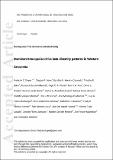Dominant tree species drive beta diversity patterns in western Amazonia
Abstract
The forests of western Amazonia are among the most diverse tree communities on Earth, yet this exceptional diversity is distributed highly unevenly within- and among communities. In particular, a small number of dominant species account for the majority of individuals while the large majority of species are locally and regionally extremely scarce. By definition, dominant species contribute little to local species richness (alpha diversity), yet the importance of dominant species in structuring patterns of spatial floristic turnover (beta diversity) has not been investigated. Here, using a network of 207 forest inventory plots, we explore the role of dominant species in determining regional patterns of beta diversity (community-level floristic turnover and distance-decay relationships) across a range of habitat types in northern lowland Peru. Of the 2031 recorded species in our dataset, only 99 of them accounted for 50% of individuals. Using these 99 species it was possible to reconstruct the overall features of regional beta diversity patterns, including the location and dispersion of habitat types in multivariate space, and distance-decay relationships. In fact, our analysis demonstrated that regional patterns of beta diversity were better maintained by the 99 dominant species than by the 1932 others, whether quantified using species abundance data or species presence/absence data. Our results reveal that dominant species are normally common only in a single forest type. Therefore, dominant species play a key role in structuring Western Amazonian tree communities, which in turn has important implications, both practically for designing effective protected areas, and more generally for understanding the determinants of beta diversity patterns.
Citation
Draper , F C , Asner , G P , Honorio Coronado , E N , Baker , T R , García-Villacorta , R , Pitman , N C A , Fine , P V A , Phillips , O L , Zárate Gómez , R , Amasifuén Guerra , C A , Flores Arévalo , M , Vásquez Martínez , R , Brienen , R J W , Monteagudo-Mendoza , A , Torres Montenegro , L A , Valderrama Sandoval , E , Roucoux , K H , Ramírez Arévalo , F R , Mesones Acuy , Í , Del Aguila Pasquel , J , Tagle Casapia , X , Flores Llampazo , G , Corrales Medina , M , Reyna Huaymacari , J & Baraloto , C 2019 , ' Dominant tree species drive beta diversity patterns in western Amazonia ' , Ecology , vol. 100 , no. 4 , e02636 . https://doi.org/10.1002/ecy.2636
Publication
Ecology
Status
Peer reviewed
DOI
10.1002/ecy.2636ISSN
0012-9658Type
Journal article
Description
This study was supported through a joint project between the Carnegie Institution for Science and the International Center for Tropical Botany at Florida International University. GPA and FCD were supported by a grant from the John D. and Catherine T. MacArthur Foundation and the Leonardo DiCaprio Foundation. Plot installations, fieldwork and botanical identification by the authors and colleagues has been supported by several grants including a NERC PhD studentship to FCD (NE/J50001X/1), an ‘Investissement d’avenir’ grant from the Agence Nationale de la Recherche (CEBA, ref. ANR-10- LABX-25-01), a Gordon and Betty Moore Foundation grant to RAINFOR, the EU’s Seventh Framework Programme (283080, ‘GEOCARBON’) and NERC Grants to OLP (Grants NER/A/S/2000/0053, NE/B503384/1, NE/F005806/1, and a NERC Postdoctoral Fellowship), and a National Geographic Society for supporting forest dynamics research in Amazonian Peru (grant #5472-95). OLP is supported by an ERC Advanced Grant and is a Royal Society-Wolfson Research Merit Award holder.Collections
Items in the St Andrews Research Repository are protected by copyright, with all rights reserved, unless otherwise indicated.
Related items
Showing items related by title, author, creator and subject.
-
Multi-species population indices for sets of species including rare, disappearing or newly occurring species
Korner-Nievergelt, Fränzi; Strebel, Nicolas; Buckland, Stephen T.; Freeman, Robin; Gregory, Richard D.; Guélat, Jérôme; Isaac, Nick; Mc Rae, Louise; Roth, Tobias; Schirmer, Saskia; Soldaat, Leo L.; Voříšek, Petr; Sattler, Thomas (2022-07) - Journal articleMulti-species indices (MSI) are widely used as ecological indicators and as instruments to inform environmental policies. Many of these indices combine species-specific estimates of relative population sizes using the ... -
Regional occupancy increases for widespread species but decreases for narrowly distributed species in metacommunity time series
Xu, Wu-Bing; Blowes, Shane A.; Brambilla, Viviana; Chow, Cher F. Y.; Fontrodona-Eslava, Ada; Martins, Inês S.; McGlinn, Daniel; Moyes, Faye; Sagouis, Alban; Shimadzu, Hideyasu; van Klink, Roel; Magurran, Anne E.; Gotelli, Nicholas J.; McGill, Brian J.; Dornelas, Maria; Chase, Jonathan M. (2023-03-16) - Journal articleWhile human activities are known to elicit rapid turnover in species composition through time, the properties of the species that increase or decrease their spatial occupancy underlying this turnover are less clear. Here, ... -
Local human population increase in the non-breeding areas of long-distance migrant bird species is only weakly associated with their declines, even for synanthropic species
Cresswell, Will; Winifred, Nanchin; Patchett, Robert Brian (2019-12-17) - Journal articleAim : To show how recent declines in populations of long-distance migrant birds are associated with recent increases in human population growth and agricultural intensification on their tropical non-breeding grounds, except ...

